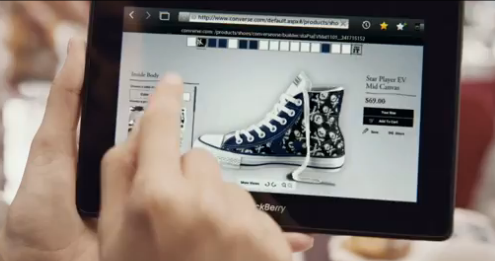Tablets And Mass Customization: A Match Made In Heaven
With a hat tip to the mass-customization.info blog, a screen shot showing that the latest Blackberry Playbook commercial depicts a mass customization experience – the Converse Design Your Own collection. (See the entire video here).

Sarah Rotman Epps is the senior analyst on my team who leads our research on tablets (and consumer computing) for product strategy professionals. She’s written extensively about the future of tablets but also about the characteristics of software and media experiences that succeed on tablets. (Forrester clients can read “Best Practices for Media Apps,” for instance). At the same time, I have written about how mass customization is finally the future of products in an age when customer-centricity reigns.
Tablets and configurators – the typical tool that consumers use to co-design customized products – are a match made in heaven. They share a number of characteristics that product strategists should consider when developing mass-customized product interfaces. For example, they both:
- Love visuals. Tablets are particularly useful for creating media-rich experiences with visual pizzazz. Configurators benefit from clear – yet evocative – visual design experiences. The key is to leverage the best attributes of the tablet form factor to highlight what products will look like for buyers.
- Require simplicity. Tablet applications work best when they are simple. They also lack built-in keyboards and mice, and must be touch-friendly. Configurators work best when they don’t overburden consumers, keeping the options simple and the minutes short. The key is to design touch-first configuration experiences with high usability and low complexity.
- Embrace curation. Tablets employ curated computing to assist and guide users by removing extraneous choices. Configurators employ curation, too – prescreening the choice set of features that can be altered, offering a narrative for co-designing consumers, and interpreting what it all means. The key is to design rich but relevant journeys that leverage the best features of tablets and reward users with great product designs.
- Reward repeat usage. Tablet media applications often employ the game mechanic to reward repeat usage. For example, Condé Nast's Gourmet Live iPad app gives users "achievements" for spending time with the app. Configurators learn about customers through past behavior, all the better to proactively predict what users will want next. The key is to drive buyers into the loyalty cycle of repeat purchasing.
Apple’s iPad (and other tablets) will help popularize mass customization further. Tablets rank high – along with smartphones and Xbox Kinect – on the list of disruptive electronics devices that product strategists should use to promulgate their mass customized offerings.
